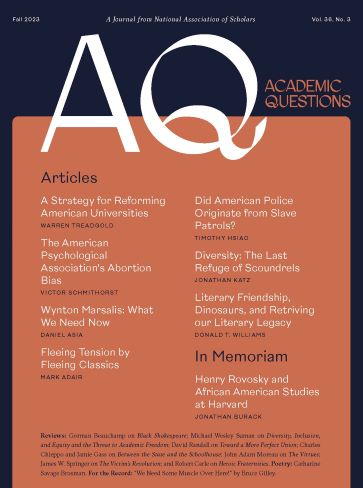Black Shakespeare: Reading and Misreading Race, Ian Smith, Cambridge University Press, 2022, pp. 212, $34.00 hardcover.
Reading Black Shakespeare took longer than reading War and Peace, although the former is only 189 pages, thirty of which are notes: it is so poorly written. A reviewer of a book of one of my professors once described reading it as akin to walking long distances over wet shale—the perfect description for Black Shakespeare. Some examples: “Directed at persons of color, the charge of identity politics is meant to delegitimize an intellectual position, casting it as an essentialist bias based in a reductively vague biological premise that recreates the familiar hierarchy of the mind-body split.” “Fetishizing historical accuracy is to claim the high moral ground of sound scholarship, a position from which to disguise resistance to race work, from which to promote a singular perspective and methodology as acceptable while placing firm restriction on others.” There’s worse: very long stretches of very wet shale. College is probably the place to learn to write that badly. But this explains the length of time it took me to read Black Shakespeare: the attic needed cleaning, Wagner’s Ring Cycle ought to be reheard. I read three other books between bouts with Smith’s, but a Puritan sense of duty, no doubt ill-founded, kept dragging me back to his.
This despite what I encountered on page ten. “Whiteness, because of its obfuscating and evasive maneuvers, struggles to contend with race,” so that most readers will be “hampered by whiteness’ inherent epistemological limitations.” Well, I was born white, most likely will die white, and was white every moment in between, so must have been hampered by my inherent epistemological limitations my whole life without ever noticing. I should feel chagrin, but the fact is that I was blessed with a very active bunkum detector to make up for my “epistemological limitation” and Black Shakespeare set it buzzing: it is bunkum, racist bunkum. Let’s be clear at the beginning: whiteness here is what capitalism is to Marxists, the patriarchy to feminists, original sin to Catholics, the source of all evil (even, we’ll see, cowardice). Smith quotes with approval this condemnation: “it is not merely that whiteness is oppressive and false; it is that whiteness is nothing but oppressive and false.” If this sort of essentialist generalization were made about any other race, black or brown, red or yellow, its racist nature would be apparent and condemned; here it is apparent—and approved, at least by the folks at Cambridge University Press.
Such a farrago of whiteness-bashing occupies the first chapters—we get to the treatment of a Shakespeare play only seventy-nine pages in—that trying to untangle and make sense of it appears unprofitable; but let me give one example of how Smith reasons. Retinal Sarcomas is the medical term for a visual abnormality, or blind spot, in certain instances affecting vision; everyone, however, has a sarcoma at the point where the optic nerve goes through the retina, where the brain fills in the empty spot. But Smith converts a purely physical phenomenon into an ideological one, the term “blind spot” too tempting not to transmogrify. White’s blind spot apparently concerns only race, their brains filling in the blanks with cultural misinformation—or something like that. Nothing about what occupies the “blind spots” of other races or even of such whites who, historically or geographically, have no knowledge of other races. This constitutes probably the most inapt appeal to science since Cultural Darwinism.
Consider this comment: one conundrum looms over Black Shakespeare: Shakespeare. Even critical race studies has not, so far as I know, discovered him to be other than a white man, subject to all the frailties of his kind, including “inherent epistemological limitations.” How is it, then, that this white man, four hundred years ago, wrote dramas of such racially perceptive, if cunningly nuanced, insights that were only discovered in the twenty-first century by an American academic, albeit Vice President of the Shakespeare Association of America? Perhaps it’s needless to point out that all four hundred plus years of prior Shakespeare criticism stands revealed as irrelevant, marked by “the incipience of racial blind spots resulting from [their] ideological conditioning.” In fact, Smith deals in any detail with only three plays, The Merchant of Venice, Hamlet, and Othello, but his ex-cathedra repudiation of the critical production pre-him would seem to be opus-wide. Consider this comment: “Shakespeare’s use of the play’s [Othello] second scene stands as an example of the importance of conscious intervention to disrupt oppressive racial orthodoxy and destabilize the sedimentation of reading and interpretive conventions.” Put aside the rhetorical biliousness of the claim, how did this sixteenth century white man find the wherewithal to achieve this effect when no other white man then or since seemed able even to grasp it? Smith makes no attempt to explain how Shakespeare so transcended the “inherent epistemological limitations” of his kith and kind as to have these super-subtle insights and convictions.
Chapter Three, the first to deal with a play, concerns The Merchant of Venice, specifically the whiteness of the pound of flesh that Shylock seeks as guarantee for his loan to Antonio, Antonio’s “fair flesh.” Although that phrase appears only once in the play, it is impossible to overstate how often Smith over-uses it, stressing not so much the “flesh” part as the “fair” part, the whiteness that Shylock seeks to overcome. For it to be a race play, which it must be to belong in Black Shakespeare, Antonio’s antagonist, Shylock, must be black, metaphorically, if not literally. In fact, Smith posits, without much conviction, that Jews were sometimes described as literally black in medieval and early modern literature, but generally seems to settle for their existence as merely the dark “other” in Merchant.
Let me make some important distinctions about the play here. I always insist that any interpretation take full account of Jessica, Shylock’s daughter, who, of course, shares his genes. She elopes with a Christian, presumably converts, heads off to Portia’s villa where she is accepted without reservation, is, with her husband, given guardianship of the villa in Portia’s absence, and, in the play’s celebratory ending, beds down contentedly in her new life. Because The Merchant is so often misread as anti-Semitic these days, Jessica proves the fly in that ointment. The play is not about race, but religion, not about genetics, but theology: otherwise Shylock’s conversion at the end would make no sense. (For anyone interested in a full discussion of these matters, see my “Shylock’s Conversion” in Humanitas, 24, 2011.)
Smith’s is not the usual anti-Semitic argument, for he proves far more interested in the skin per se than the DNA beneath it. He seems intent, like his intellectual cohort generally, on forcing whites to see their race as only one among many, not the default norm by which all others are judged. There are numerous ancillary issues complicating this chapter, but as best I can make out Shylock’s purpose in refusing monetary payment for the bond is his unappeasable desire to “own” this pound of white flesh as a commodity (as the flesh of blacks will be in the transatlantic slave trade a century later), thereby challenging the hitherto unquestioned dominance of whiteness in Venice. Smith represents Antonio’s role in this bargain thus: “Shakespeare insists on exposing white violence in the person of Antonio, whose corrosively dehumanizing attitude triggers the revolt against his white flesh and the culture of bias it represents.” Antonio, that is, brings this danger on himself by . . . being white.
Smith focuses on only two scenes in the play, the making of the bargain and its legal outcome in the trial scene, mostly ignoring all else, most conspicuously Jessica. But even the trial scene he cuts in half, failing to acknowledge its true significance. At first Shylock demands his pound of flesh against all efforts to dissuade him from that action (presumably, per Smith, to punish the Venetians for not accepting him as an equal). Portia delivers her “Quality of Mercy” speech in an effort to elicit kindness, forgiveness; he refuses. But note, the person she is trying to protect here is not Antonio—of all the people in the court she alone knows that he stands in no real danger—but Shylock, who, by proceeding, is signing his own death warrant: invoking the law that punishes capitally any alien who threatens the life of a Venetian. When she says that Shylock may have his pound of Antonio’s flesh, but not a drop of his blood, all are stunned; the “rebellion” collapses and Shylock must sue for his life. Smith’s reading is, “Portia unveils the infamous legal technicality that . . . vitiates the contract.” The legal technicality is the law of Venice (odd, admittedly, that no one was aware of it before) on which previously Shylock had insisted be followed. But, in truth, the law is Shakespeare’s own making. No one in his audience, nor even he had any real knowledge of the laws of Venice; the stipulation was his purely fictive invention to bring the drama to the conclusion he desired. At this point Smith is off on something about blood, unwilling to follow the scene to its end.
For that subsequent part of the scene shows the Venetians—whites—treating Shylock kindly, under the circumstances: sparing his life, leaving him free, remitting half of his fortune—which should have gone to the Duke—back to him, the other half to his daughter and her husband, but, of course, on condition that he convert to Christianity. That demand, which causes considerable consternation among moderns, nevertheless shows all the anti-Semitic readings wrong: religion not genetics sets Shylock apart. And to these conditions he replies, “I am content.” No reason not to believe him: a sadder but a wiser man. And the last act returns the play’s jeunesse doree—all white—to Belmont to celebrate the comedy’s happy ending.
In light of the whole play, I offer this conclusion of Smith’s as an example of his mind at work and the tendenz of his criticism: “The seeming unwillingness among scholars to address the textual evidence, admit its racial content, and grapple with Shakespeare’s critique of whiteness has only reproduced . . . one of whiteness’s most strategically ontological and political maneuvers: invisibility that renders the text racially irrelevant.” What’s to be said?
The next chapter, on Hamlet, depends on a misread word. In the scene in his mother’s bedroom (III, iv) Hamlet in a frenzied criticism of her remarriage, showing her pictures of her two husbands, asks: “Have you not eyes?/ Could you on this fair mountain leave to feed,/ And batten on this moor?” The comparison is rather simple: could you leave the rich food of the fair mountain for the debased fare of the lowland, the moor. Given the dark glasses through which he reads the play, Smith discovers a supposed pun here—he will subsequently, frequently reproduce it as Moor—that is, reference to a black man, specifically Claudius, the murderer of his father. In my reading—and I presume most everyone else’s—the comparison is simply one place, mountain, to another place, moor; in Smith’s, it goes from one place to a person, mixing the metaphor. It is one thing to imagine Gertrude eating at a place, another to imagine her eating a person. “Moor” construed as a black man is the error from which this whole chapter enucleates—although Smith would have us view the eschewing of a capital “M” for moor as refusing to see the racial content of the play. In Hamlet’s mind, he deduces from this one word, “violence is already racialized and attached specifically to a black identity and population.”
There is a lot to unpack here. First, in a book the ostensible purpose of which is to project a more positive image of blacks than whites usually entertain, having “the deceitful, murderous Claudius a ‘Moore,’” as Hamlet (supposedly) characterizes him, seems counterproductive. Second, how can a single word, uttered halfway through the play, carry all the implications that Smith attributes to it, particularly if one is only hearing it? Some critics are honest enough to admit that there is a Shakespeare of the theater and a Shakespeare of the study and that the complicated, convoluted theories they devise after repeated readings are next to impossible to convey on stage. Can a hearing of the phrase “batten on a moor” really register Claudius as a black man in the eyes of an audience? Can it even have had that effect on a reader in the study—before Ian Smith—or after? Nevertheless, he will continue to refer to Claudius as a black man, the Moor, throughout this chapter.
True, Smith does try to substantiate his claim by his treatment of a scene before Hamlet’s “pun,” the players’ scene, the play-within- a-play. Hamlet knows these players before their arrival at Elsinore and knows that their repertoire includes The Murder of Gonzaga which he commands they play before Claudius in order to “catch the conscience of the King”: he hopes the similarity of the acted crime to the real one will force his uncle’s guilt to the surface. This, of course, is patent: Hamlet explains his plan. What he doesn’t explain is that—Smith now—they will play it in blackface so as to make the identification to Claudius all the more obvious, to whom, other than the regicide, is not clear. Nothing said by any character in the play, nothing anywhere in the stage directions suggests this to be the case, unless one has Smith’s blaydar (the black version of gaydar). Example:
Shakespeare’s use of the racially resonant [?] “damnable faces” makes it clear that the actor’s rehearsed facial set-pieces belong to the specific category of the over-wrought facial contortions of the stage Moor. . . . The phrase “damnable faces” thus denotes the exaggerated expressions of the white actor that would be magnified through the application of face-blackening agents.
Hamlet, however, is warning against the actor’s adopting the exaggerated black villain stereotype, which, one would think, he would have urged to help implicate Claudius in specifically black villainy. But, of course, nothing suggests that The Murder of Gonzaga was played out in blackface—or that anyone would have known why it was if it was. In any event, Smith concludes his negrification of Claudius with, “Hamlet uses this racial spectacle . . . to materialize the ideological argument he has nursed throughout: Claudius is the murdering ‘Moore.’ Criminality and racial blackness conflate dangerously, making African identity, signaled in the category ‘Moore,’ the baseline for moral depravity.”
I repeat that this is a strange argument in a book meant to resuscitate the reputation of the black man; but how is Hamlet himself implicated in the equation: black = evil? Smith turns to the genre of the revenge tragedy, to which Hamlet supposedly belongs. He cites a critic who writes that the genre “is usually understood to center around a figure who considers himself to have been seriously wronged, and who . . . contrives eventually to extract retribution, becoming in the process as depraved as those by whom he had been wronged.” It is the last part of the sentence, along with another critic’s determination that the protagonist comes increasingly to resemble “the villain whom he stalks,” that stir Smith’s interest, his way to darken, if not entirely blacken, the grieving prince. The “To be or not to be” soliloquy winds down with “Conscience does make cowards of us all.” Smith argues, “Since cowardice manifests as a form of whiteness it comes as no surprise that Hamlet construes action as having a contrasting color designated by the blackness of ‘great pitch.’” In other words conscience is white (and cowardly?), the will-to-action, black, Claudius-like. “Hamlet contemplates himself, a white man, becoming black . . . to assert his total and complete embrace of heedless violent action.” That Hamlet is torn between wanting to act and unable to do so hardly comes as news: it is the central problem of the play, infinitely discussed, but to racialize these contrary impulses is possible only if one accepts Smith’s Claudius-as-Moor motif. Long before Shakespeare, blackness, darkness, night were associated with evil and ignorance, with no reference to somatic skin color implied, as whiteness characterized innocence, goodness, light, again with no reference to skin color: archetypes, at least in Western culture. Being evil makes Claudius black only metaphorically.
Even Hamlet’s clothes in his first scene, black, the utterly traditional color for mourning, is, Smith claims—although the play has just begun—“already immersed in the racial discourse of black skin,” establishing “the image of Hamlet as the white actor in racial drag.” Even in the talk of his mourning his father’s death, Shakespeare “consistently shift[s] the discourse from mourning to Mooring—the art of becoming a Moor, impersonating a black man through clothing on the stage,” this long before the moor-Moor “pun” is uttered that (supposedly) reveals Claudius’s character. Sequence seems to have no significance, for when viewed through a glass darkly, everything everywhere is about race.
The upshot of “black Hamlet,” however, reveals that Hamlet is not black at all, only a white man in racial drag (Smith’s best line). Hamlet only assumes the black man persona to indulge his savage revenge fantasies, that his white (cowardly) conscience inhibits his acting on. The most significant impression left by Shakespeare's most famous play, Smith concludes, is that we should all think less of Hamlet because of his racial insensitivity. “In light of Hamlet’s deeply flawed attitude toward blackness, readers must rethink what it means to maintain their esteem for this prince as literary hero.”
White violence—enslavement, subjugation, control through physical discipline, death—Smith claims, “is muted . . . in the post-Enlightenment history of Hamlet.” In fact, except for death, I don’t recall any of the subjects figuring in Hamlet at all. But this “leads to the failure to recognize the play’s complicity in constructing the damaging myth of the . . . Murderous Black Man . . . through the cultural institution of the theater.”
There is so much wrong here, I hardly know where to start. Let’s begin with Hamlet’s racist attitudes: these are revealed, per Smith, in such things as wearing black clothes and “putting an antic disposition on” which, in fact, he warns against. Except for making Achilles’ son Pyrrhus black in some lines of poetry Hamlet quotes (on which Smith spends five pages), I don’t think there is mention of a black person in the play, pro or con: unless, of course, you are counting his metaphorical Moor. There are cases of people who hear messages from extraterrestrials in rock music or see the Blessed Virgin on a piece of burnt toast: Smith’s discovery of racism in Hamlet is of that order.
Then there is the matter of Hamlet’s supposed contribution to the image of the Violent Black Man, with us still. Wouldn’t there have to be a violent black man in the play for the play to reenforce this stereotype? And there isn’t, except Claudius, who is a Moor in Smith’s imagination of Hamlet’s imagination in one very probably misinterpreted line, but in no other way. Aaron the Moor in Titus Andronicus—and perhaps even Othello—could be said to contribute to the Violent Black Man syndrome, which now consists of whom?—Bigger Thomas, Shaft, Mike Tyson? Nothing in Hamlet, certainly not Hamlet, points in that direction.
When he finally turns to a play with a black man in it, Othello, he poses this question: “How can a largely white Shakespeare industry tell the story of race?” We recall, of course, his assertion of “whites’ inherent epistemological limitations,” which would render the process problematic. But we should establish an unconverted fact here at the beginning. This black man’s story is a white man’s black man’s story: Shakespeare was, remember, white. Othello is of the same category as Twain’s Jim in Huckleberry Finn, Lucas Beauchamp in Faulkner’s Intruder in the Dust, and William Styron’s Nat Turner in The Confessions, black creations of white men. If Shakespeare were writing Othello today, he would no doubt be accused, by Smith’s cohort, of cultural appropriation. How had Shakespeare overcome “the white’s inherent epistemological limitations” to write this play? Smith never addresses that matter; it never, in fact, seems to have occurred to him. But his question, properly adjusted, becomes “can whites understand a racial play written by a white man?”—rather a different matter.
To answer that question that he never quite asks, Smith’s answer is: no. No white can ever fulfill Othello’s dying request, “Speak of me as I am,” for no white is racially capable of truly understanding his story. But, while whites cannot or will not, not all is lost: “Can we, contemporary critics”—and, of course, he means black critics—“reliably tell his story?” To the rescue: we must “become the kind of reliable cultural narrators and race thinkers Othello envisions.” All I can say is that it is extremely hard to believe that Othello ever envisioned an Ian Smith. His dying speech, in any case, explaining himself, goes in a direction entirely different from this critic’s.
He accepts his guilt rather than attenuating it: “one that lov’d not wisely, but too well; one whose hand/ (Like the base Indian) threw a pearl away/ Richer than all his tribe.” His final comment recounts an act in defense of Venice:
And say besides that in Aleppo once,
Where a malignant and a turban’d Turk
Beat a Venetian and traduc’d the state,
I took by the throat the uncircumcised dog
And smote him—thus. . .
At which point he stabs himself, in remorse.
In his discussion Smith speaks of Othello’s “racial anxiety and self-hate,” of “Othello’s mounting internalized racism,” of his becoming “the agent of his own destruction.” So negative seems the impression that Othello creates, that some black actors today—including Sidney Poitier—have refused to play the part. What, then, will Smith’s crew of black critics say to alter this, to keep Othello from appearing that feared stereotype, the Violent Black Man who murders his wife?
The answer comes, I think, in this sentence: “The public’s ability to perceive and speak coherently about black persons is fundamentally undermined by the kind of racial disjunction Othello intuits and that has become even more . . . pronounced with time” (my emphasis). The answer, that is, lies not in the play itself, but in Othello’s intuition of what is to come: the exploitation, degradation, enslavement, and murder of black men of the four hundred years to come.
This is not conjecture on my part, for this sentence occurs just after a five-page recounting (out of the chapter’s nineteen pages) of our nation’s terrible history of treatment of blacks, in the crispest, most telling writing in the book. I have no quarrel with his account of what has righteously been called our national “origin sin.” But I do quarrel with the essentialism that he attributes to whites as a race and which renders them incapable of grasping that this tale of horrors is wrong. Infinite variations and gradations of opinion on matters of race exist among white people, as, indeed, they do among blacks: I doubt that Smith would think Clarence Thomas or Hershel Walker the ideal readers of Othello as he sees it. And even some of the writers he cites to make various points are white—Judith Butler, for example.
In short, Othello says, “Speak of me as I am,” and its meaning has always been evident to readers/viewers of all races. What Smith believes his new black critics offer is meaning beyond the play, created by history: “Speak of me as I will be.” Can one, in all honesty, however, believe that Shakespeare had the sort of prescience of what was to come to endow his creation with that imagination? As with his view of Hamlet, no possible production of Othello could enact his theory: maybe you can imagine Othello somehow looming over George Floyd, but you can’t imagine George Floyd as a part of Othello. History doesn’t work backward; you can learn from history, you can’t change it. Smith reveals nothing new about the play per se, offering it only as a tea leaf for future prediction.
In searching for a rationale for Black Shakespeare, my best guess is that it stems from ideology-tinged racial guilt. If your occupation is teaching English Lit. you obviously can’t be doing much, professionally speaking, to aid “the movement”—not like, say, community organizing; you seem too comfortably ensconced in a white vocation. But if you could somehow upend that field of study—arguing that Chaucer or Jane Austen or Emily Dickinson or, wait, best of all, Shakespeare, the giant, were writing texts with as yet undiscovered, cunningly encoded, black messages that no whites, epistemologically limited, could ever decipher—then you might feel that you had made a noteworthy contribution to the cause. And the slander of the white race would be a lagniappe.
Black Shakespeare, I think, is a shoddy and dishonest book. Nowhere, in any way, is the adjective black legitimately attendant to Shakespeare’s name. The book in no way justifies making a claim to have dealt with Shakespeare’s opus, discussing only three plays, two of which don’t have a black man in them. Inferences are treated as facts, passages misinterpreted, supposed evidence strained or non sequitur, inconvenient figures or facts ignored. The book’s subtitle—Reading and Misreading Race—is at least half right.
Gorman Beauchamp is the author of a book on Jack London and essays on subjects ranging from Shakespeare to science fiction; [email protected]. Beauchamp is also an associate professor emeritus of humanities at the University of Michigan. He last appeared in these pages in the summer of 2022 with “Two Good Words for Colonialism: Hong Kong.”














